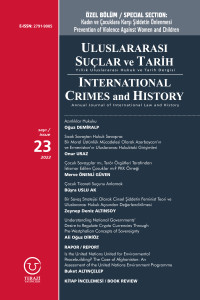Abstract
Minority is one of the two important concepts in international law that have not been definitively defined yet. Very few countries have homogeneous population in ethnic, religious and/or religious terms. Minority law, despite the ambiguity of the universal definition, is a branch that has been around for centuries. If we take the law of minorities as a relationship of states with minorities on their land, we can go back to the earliest milestone. However, it is a broad consensus that the law of minorities, in modern history, began to evolve with the 1648 Westphalia Treaty, unless some early examples, such as the 1598 Treaty of Nantes, envisioning France’s revenge on protestants.
References
- Anna Adorjáni ve László Bence Bari, “National Minority: The Emergence of the Concept in the Habsburg and International Legal Thought”, Acta Universitatis Sapientiae, European and Regional Studies 16, sy 1 (01 December 2019): 7-37, https://doi.org/10.2478/auseur-2019-0010.
- Joseph B Kelly, “National Minorities in International Law”, Denver Journal of International Law & Policy 3, sy 2 (January 1973): 23.
- John R Valentine, “Toward a Definition of National Minority”, Denver Journal of International Law & Policy 32, sy 2 (Ocak 2004): 31.
Abstract
Azınlık, uluslararası hukukta kesin tanımı henüz yapılamamış olan iki önemli kavramdan biridir. Etnik, dinsel ve / veya dinsel açılardan homojen nüfusa pek az ülkede rastlanır. Azınlıklar hukukuysa, evrensel tanım belirsizliğine rağmen, yüzyıllarca geçmişi olan bir daldır. Azınlıklar hukukunu devletlerin kendi topraklarında azınlıkta olanlarla ilişkisi olarak alırsak milat öncesine kadar inebiliriz. Ancak, modern tarih çerçevesinde azınlıklar hukukunun, Fransa’nın protestanlara höşgörü öngören 1598 Nantes Buyrultusu gibi birkaç erken örnek sayılmazsa, 1648 Westphalia Antlaşmasıyla gelişmeye başladığı üzerinde geniş mutabakat olan bir saptamadır.
References
- Anna Adorjáni ve László Bence Bari, “National Minority: The Emergence of the Concept in the Habsburg and International Legal Thought”, Acta Universitatis Sapientiae, European and Regional Studies 16, sy 1 (01 December 2019): 7-37, https://doi.org/10.2478/auseur-2019-0010.
- Joseph B Kelly, “National Minorities in International Law”, Denver Journal of International Law & Policy 3, sy 2 (January 1973): 23.
- John R Valentine, “Toward a Definition of National Minority”, Denver Journal of International Law & Policy 32, sy 2 (Ocak 2004): 31.
Details
| Primary Language | Turkish |
|---|---|
| Subjects | Law in Context |
| Journal Section | Commentary |
| Authors | |
| Publication Date | September 26, 2022 |
| Published in Issue | Year 2022 Issue: 23 |


